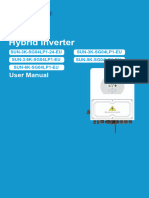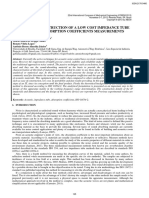LCS Lab1
LCS Lab1
Uploaded by
Ethan CoyneCopyright:
Available Formats
LCS Lab1
LCS Lab1
Uploaded by
Ethan CoyneOriginal Title
Copyright
Available Formats
Share this document
Did you find this document useful?
Is this content inappropriate?
Copyright:
Available Formats
LCS Lab1
LCS Lab1
Uploaded by
Ethan CoyneCopyright:
Available Formats
Laboratory 1
LCS-1 R EMOTE P OSITION -C ONTROL
S ERVOMECH ANISM
Introduction
The equipment set up is shown below in Figure 1 along with a block diagram
representation in Figure 2.
Figure 1 Remote position control servomechanism
C(s)
R(s) + E(s) M(s)
Gctrl(s) Gplnt(s)
_ −
B(s)
Hfbk(s)
Figure 2 Block diagram of RPC servomechanism
Identify which of the block diagram components each of the following circuit
devices relates to:
Summing amplifier:
EE Dept., NUI Galway 1 Third Year Laboratories
Gain control potentiometer:
Drive motor:
Tacho potentiometer:
Write an expression for the closed-loop transfer function, C(s)/R(s):
25.1 Proportional Control
The system is connected as above and the tachometric feedback is initially set at zero.
When tested, the system became unstable when the gain was raised to:
K=
With the gain reduced in accordance with the Ziegler-Nichols rule for proportional
control, the following results were obtained for a step input of ϕc = 60 degrees:
Gain setting =
Dead band (estimate) = 5 degrees
Overshoot (estimate) = 30%
Given that the output settled ~ 2.5 s after application of the step input, sketch the system step-
response below. Choose suitable ranges for time and angular position for the axes of your graph.
Marks will be given for neat waveforms that include good attention to detail on axes markers, etc.
ϕc, o
time, s
Figure 3 Step response with proportional control
EE Dept., NUI Galway 2 Third Year Laboratories
25.2 Proportional with Tachometric Feedback
The following results were obtained for a step input of ϕc = 60 degrees with the gain and
velocity feedback settings adjusted to give fast response with minimal overshoot.
Gain setting =
Velocity feedback =
Dead band = 2.5 degrees
Overshoot = 15%
Given that the output settled approximately 1 s after application of the step, sketch the
step response below. Use hte same range of values as used in Figure 3 so that the
waveforms can be easily compared.
ϕc, o
time, s
Figure 4 Step response with tachometric feedback
Explain your understanding of how tachometric/derivative feedback works in terms of the
mathematical definition of derivative action. Include a diagram/figure to help your
explanation.
EE Dept., NUI Galway 3 Third Year Laboratories
25.3 Bandwidth
Explain how to measure the bandwidth of a system using sinusoidal test signals:
EE Dept., NUI Galway 4 Third Year Laboratories
Retaining the settings of part 2 the manual input was replaced with a sinusoidal
reference input from a low-frequency signal generator and the bandwidth of the servo
was measured as:
Bandwidth = Hz
25.4 Use as Scanner
Retaining previous controller settings, the signal generator was used to command
repeated forward and backward linear scans between ±30° at a rate of one cycle per
second.
Add a sketch to the plot in Figure 25.5 below showing the nature of the response
waveshape relative to the command signal. Mark values of angular position and time
on the axes:
Figure 5. Expected scanner response
Explain the differences between the command and response waveshapes in Figure
25.5:
EE Dept., NUI Galway 5 Third Year Laboratories
Explain why the waveshape of the response signal changes so much when the repetition
rate of scanning increases:
EE Dept., NUI Galway 6 Third Year Laboratories
You might also like
- BME3132 Lab 6 ReportDocument4 pagesBME3132 Lab 6 ReportEthan Coyne50% (2)
- Mec 2 Microprocesador ThomsonDocument90 pagesMec 2 Microprocesador ThomsonNubia ArizaNo ratings yet
- ME2142-1 Formal Lab ReportDocument5 pagesME2142-1 Formal Lab Reportzhejun90No ratings yet
- Ee4302 Ca1Document51 pagesEe4302 Ca1Norul Ashikin NorzainNo ratings yet
- SSCA SIP Training - Course DetailsDocument23 pagesSSCA SIP Training - Course DetailsshethNo ratings yet
- AkhilsinghDocument13 pagesAkhilsinghalpha kumarNo ratings yet
- Double Integrator SystemsDocument4 pagesDouble Integrator SystemsRick GongNo ratings yet
- 1672 6340 (2012) 01 0007 08 PDFDocument6 pages1672 6340 (2012) 01 0007 08 PDFbacuoc.nguyen356No ratings yet
- Design of Hall Effect SensorsDocument8 pagesDesign of Hall Effect SensorsMrinal MitraNo ratings yet
- Pseudo Random Binary Sequence On Second Order SystemDocument4 pagesPseudo Random Binary Sequence On Second Order SystemRené PereiraNo ratings yet
- Lab 3Document6 pagesLab 3bassmalabaraaNo ratings yet
- Design Problem Matlab Project TFDocument19 pagesDesign Problem Matlab Project TFhumayun azizNo ratings yet
- ELE 4623: Control Systems: Faculty of Engineering TechnologyDocument14 pagesELE 4623: Control Systems: Faculty of Engineering TechnologyMaitha SaeedNo ratings yet
- C&i Lab-2019Document67 pagesC&i Lab-2019aniruthNo ratings yet
- CONTROL THEORYDocument17 pagesCONTROL THEORYNikhil KNo ratings yet
- 2.004 Dynamics and Control Ii: Mit OpencoursewareDocument7 pages2.004 Dynamics and Control Ii: Mit OpencoursewareVishay Raina100% (1)
- ELE 4623: Control Systems: Faculty of Engineering TechnologyDocument14 pagesELE 4623: Control Systems: Faculty of Engineering TechnologyMaitha SaeedNo ratings yet
- Implementation and Test Results of A Wide-Area Measurement-Based Controller For Damping Interarea Oscillations Considering Signal-Transmission DelayDocument8 pagesImplementation and Test Results of A Wide-Area Measurement-Based Controller For Damping Interarea Oscillations Considering Signal-Transmission Delaya_almutairiNo ratings yet
- Controller of Dynamic Reactive Power Compensation Based On FPGADocument7 pagesController of Dynamic Reactive Power Compensation Based On FPGANicholas KnappNo ratings yet
- Frequency Response of System (Bode Diagram & Nyquist Plot)Document12 pagesFrequency Response of System (Bode Diagram & Nyquist Plot)Athirah Abd AzizNo ratings yet
- Exercise 8 Frequency Response and Compensation of Lead ProcessDocument6 pagesExercise 8 Frequency Response and Compensation of Lead ProcessKarthik WarrierNo ratings yet
- Antenna Azimuth:An Introduction To Position Control SystemsDocument4 pagesAntenna Azimuth:An Introduction To Position Control SystemsMpho Senior0% (1)
- Sub. Name: Ae6505 Control Engineering Answer Key Semester/Year: V / Iii Cat-1 Part-ADocument12 pagesSub. Name: Ae6505 Control Engineering Answer Key Semester/Year: V / Iii Cat-1 Part-AgallantprakashNo ratings yet
- Exp 1Document33 pagesExp 1k4nishkkNo ratings yet
- CS Lab ManualDocument28 pagesCS Lab Manualkcop111No ratings yet
- Cuk Control PDFDocument57 pagesCuk Control PDFPraveen PJNo ratings yet
- EE582 Control Techniques Laboratory Report Jeswin Mathew 200901475Document11 pagesEE582 Control Techniques Laboratory Report Jeswin Mathew 200901475Jeswin MathewNo ratings yet
- EE Lab Manuls Fast NuDocument83 pagesEE Lab Manuls Fast NuMuhammad SaadNo ratings yet
- USC PESC04 PHIL Power Interface Final PDFDocument5 pagesUSC PESC04 PHIL Power Interface Final PDFMalik MilakNo ratings yet
- EX-602 Control SystemDocument27 pagesEX-602 Control SystemdeepaknayanNo ratings yet
- Tutorial SheetsDocument11 pagesTutorial SheetsKAMARAJU SAI VAMSHINo ratings yet
- 656 OrtegaDocument6 pages656 OrtegaAnonymous WkbmWCa8MNo ratings yet
- Bilkent University EE451/551 Microwaves Experiment Purpose:: ZG 50 50 Z Z VG 206.000km/sec V 22.8Document1 pageBilkent University EE451/551 Microwaves Experiment Purpose:: ZG 50 50 Z Z VG 206.000km/sec V 22.8pandaros09No ratings yet
- 6 TH Sem 2022Document23 pages6 TH Sem 2022AnkitNo ratings yet
- Ade - CH 2CDocument12 pagesAde - CH 2Cvisutandel21No ratings yet
- lm12 tfDocument12 pageslm12 tfMuhammad SulemanNo ratings yet
- Lab 9 - Cylinder Position Control With PID ControllerDocument14 pagesLab 9 - Cylinder Position Control With PID ControllerAlex GrattonNo ratings yet
- علي احمد جباره تقرير تقرير مختبر الكونترولDocument6 pagesعلي احمد جباره تقرير تقرير مختبر الكونترولسيد نعيمNo ratings yet
- EEE 101 Experiment 2: Feedback Implementation and Error SignalsDocument6 pagesEEE 101 Experiment 2: Feedback Implementation and Error SignalsHahns Anthony GenatoNo ratings yet
- AS3842Document10 pagesAS3842kik020No ratings yet
- EE380 Lab Experiment 06Document6 pagesEE380 Lab Experiment 06khaled fawazNo ratings yet
- A Simple and Ultra-Fast DSP-Based Space Vector PWM Algorithm andDocument6 pagesA Simple and Ultra-Fast DSP-Based Space Vector PWM Algorithm andShiviAroraNo ratings yet
- Proportional and Derivative Control DesignDocument5 pagesProportional and Derivative Control Designahmed shahNo ratings yet
- Analog Integrated Circuit Design: Nagendra KrishnapuraDocument26 pagesAnalog Integrated Circuit Design: Nagendra KrishnapuraAnkit Bhoomia0% (1)
- FPGA Implementation of Simplified SVPWM Algorithm For Three Phase Voltage Source InverterDocument8 pagesFPGA Implementation of Simplified SVPWM Algorithm For Three Phase Voltage Source InverterVenkata Krishna AndeyNo ratings yet
- Self-Tuning Adaptive Algorithms in The Power Control of Wcdma SystemsDocument6 pagesSelf-Tuning Adaptive Algorithms in The Power Control of Wcdma SystemsSaifizi SaidonNo ratings yet
- ADEL Lab ManualDocument44 pagesADEL Lab ManualRehan KitturNo ratings yet
- 8.1. Lab ObjectiveDocument6 pages8.1. Lab ObjectiveJang-Suh Justin LeeNo ratings yet
- Experiment 03 - Automated Scalar Reectometry Using Labview: ECE 451 Automated Microwave Measurements LaboratoryDocument6 pagesExperiment 03 - Automated Scalar Reectometry Using Labview: ECE 451 Automated Microwave Measurements LaboratoryJuan SaldivarNo ratings yet
- 2 Muhammad RehanDocument7 pages2 Muhammad Rehanengrzee5516No ratings yet
- Software Phase Locked LoopDocument7 pagesSoftware Phase Locked LoopBinyam YohannesNo ratings yet
- Characterization of High-Q Resonators For Microwave Filter ApplicationsDocument4 pagesCharacterization of High-Q Resonators For Microwave Filter ApplicationshazardassNo ratings yet
- Assignments QuestionsDocument11 pagesAssignments QuestionsSetu Patel50% (2)
- Lab 3Document3 pagesLab 3HiNo ratings yet
- Using An Appropriate Software Package Express The Following Algebraic Fraction As Partial FractionsDocument5 pagesUsing An Appropriate Software Package Express The Following Algebraic Fraction As Partial FractionsAnuruddha WijerathneNo ratings yet
- Lab+IV Quanser PDFDocument7 pagesLab+IV Quanser PDFZakNo ratings yet
- Control Lab5Document11 pagesControl Lab5andreatalamonti85No ratings yet
- PID Analitico Conversor BuckDocument8 pagesPID Analitico Conversor BuckOdair TrujilloNo ratings yet
- Assignment Control SystemDocument19 pagesAssignment Control Systembep23090005No ratings yet
- Online Control of SVC Using ANN Based Pole Placement ApproachDocument5 pagesOnline Control of SVC Using ANN Based Pole Placement ApproachAbdo AliNo ratings yet
- Fundamentals of Electronics 3: Discrete-time Signals and Systems, and Quantized Level SystemsFrom EverandFundamentals of Electronics 3: Discrete-time Signals and Systems, and Quantized Level SystemsNo ratings yet
- Reference Guide To Useful Electronic Circuits And Circuit Design Techniques - Part 2From EverandReference Guide To Useful Electronic Circuits And Circuit Design Techniques - Part 2No ratings yet
- Aerodynamics & Hydraulics Laboratory: Laboratory Report Cover PageDocument3 pagesAerodynamics & Hydraulics Laboratory: Laboratory Report Cover PageEthan CoyneNo ratings yet
- FD Lab5BDocument4 pagesFD Lab5BEthan CoyneNo ratings yet
- Lab 3 ME352Document9 pagesLab 3 ME352Ethan CoyneNo ratings yet
- RobosapienhackDocument85 pagesRobosapienhackMike StrongNo ratings yet
- 802.11n Under The MicroscopeDocument6 pages802.11n Under The MicroscopeOwaisKhanNo ratings yet
- Osi Model and TCP AssignmentDocument7 pagesOsi Model and TCP AssignmentFrancis PulaiziNo ratings yet
- Instructions - Sun 3 6k sg04lp1 Eu - 240203 - enDocument50 pagesInstructions - Sun 3 6k sg04lp1 Eu - 240203 - enilhamoffice10No ratings yet
- GST-IFP8 - DS10104799 DatasheetDocument3 pagesGST-IFP8 - DS10104799 Datasheetasombrado_jeraldNo ratings yet
- SyllabusDocument2 pagesSyllabusShubh AroraNo ratings yet
- PA330 Multi-Function Power Meter: FeaturesDocument2 pagesPA330 Multi-Function Power Meter: FeaturesNadya Mariela ShamaraNo ratings yet
- Denon DN 2000fDocument67 pagesDenon DN 2000fDimitar SimeonovNo ratings yet
- Types of Network: Introduction To Data Communications and NetworkingDocument2 pagesTypes of Network: Introduction To Data Communications and NetworkingleeyiwenNo ratings yet
- 002-10289 CE210289 PSoC 4 CapSense Linear SliderDocument13 pages002-10289 CE210289 PSoC 4 CapSense Linear SliderAlexander VillaNo ratings yet
- LTBT VLC 444 PDFDocument2 pagesLTBT VLC 444 PDForen_yulNo ratings yet
- SystemLevel Design and Simulation of A Bluetooth ReceiverDocument10 pagesSystemLevel Design and Simulation of A Bluetooth ReceiverterrozerNo ratings yet
- Baseus W04 ProDocument43 pagesBaseus W04 ProcleibsonNo ratings yet
- FIR Filter Project ReportDocument12 pagesFIR Filter Project ReportDebayan ChatterjeeNo ratings yet
- Setupand Postprocessing and LabviewDocument11 pagesSetupand Postprocessing and LabviewtruptiNo ratings yet
- SymcomponentsDocument619 pagesSymcomponentsredoctober24No ratings yet
- Dupont 2015Document6 pagesDupont 2015Santhosh H ANo ratings yet
- Baseband Blue ToothDocument2 pagesBaseband Blue Toothpriyanka_lakshmi093907No ratings yet
- MD655/MD655G: Digital Mobile RadiosDocument4 pagesMD655/MD655G: Digital Mobile Radiosdiklatkerja digitalNo ratings yet
- Bvh-Baraa2023 11 22-1Document66 pagesBvh-Baraa2023 11 22-1gadgetnaadamNo ratings yet
- Semiconductor KIA78R05API KIA78R15API: Technical DataDocument8 pagesSemiconductor KIA78R05API KIA78R15API: Technical Datajmbernal7487886No ratings yet
- Wireless, Mobile Computing and Mobile CommerceDocument25 pagesWireless, Mobile Computing and Mobile CommerceRocklimNo ratings yet
- Embedded ControllerDocument284 pagesEmbedded ControllerKumar TalrejaNo ratings yet
- LD117Document12 pagesLD117shamnoorcafeNo ratings yet
- DDLMV1 English ManualDocument19 pagesDDLMV1 English ManualTaumar Morais0% (1)
- Physical Unclonable Function (PUF) Based Random Number GeneratorDocument7 pagesPhysical Unclonable Function (PUF) Based Random Number GeneratorAnonymous IlrQK9HuNo ratings yet
- MBR0530T1GDocument4 pagesMBR0530T1GonafetsNo ratings yet
- 4090-9101 Modulo Zona ZAMDocument2 pages4090-9101 Modulo Zona ZAMJ Luis CallasNo ratings yet





























































































